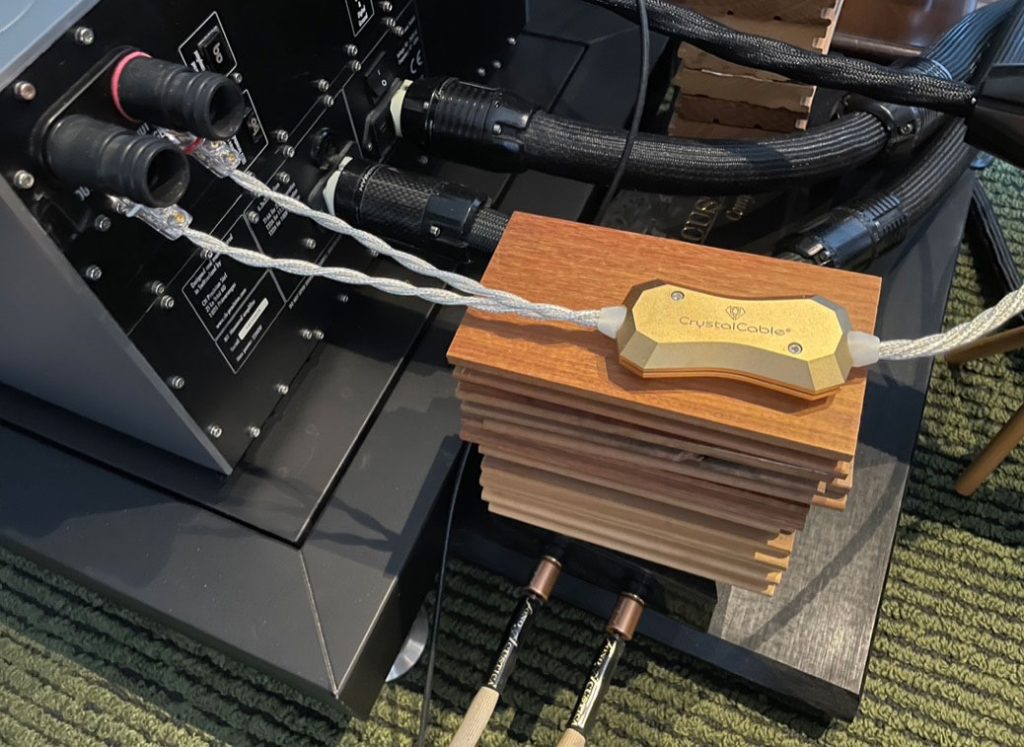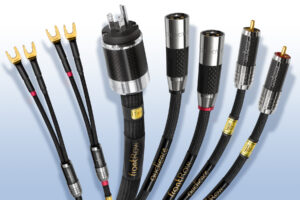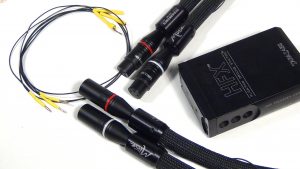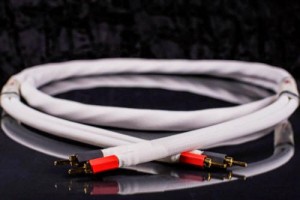In the brightly lit labs of the professional or the informal workshops of the DIYer, cable designers labor diligently, permuting materials, listening critically, then doing it again, ad infinitum. The process mandates a high degree of scientific rigor. With experience, the designer acquires an intimate understanding of their materials. They know when they tweak this it will impact that. One readily sees how the wire's voicing comes to be, ultimately, a manifestation of the designer's taste.
Thus, it seems to me, the success of the endeavor hinges on how well the team is acquainted with live sound. How else can the product speak true to our ears? In that regard, I can think of nothing more valuable in an audio designer's resume than "Occupation: professional musician." Top-shelf wires don't just materialize out of thin air.
The Monet Power Cable
These ruminations arose after posting a review of the Monet Power Cable from Crystal Cable. I chose to illustrate how the Monet PC moved beyond the pure silver conductor stereotype using the Chopin Piano Concerto No. 2. That prompted a followup email from Gabi Rynveld, the founder of Crystal Cable, in which she revealed, "As you may know, I am a concert pianist myself, having played the Chopin concerto many times—this review touches some strings…" Her main gig is as a concert pianist. Cable design is a secondary occupation. You can see how making music and making audio products join in a feedback loop in her role as a member of the design team.
Infinite Crystal Silver (iCS)
Crystal Cable and its sister company Siltech have long been famous for their silver-gold alloy, where silver conductors are injected with pure gold to fill in the naturally occurring micro-cracks that occur when the metal is drawn. They discovered a process that eliminates the gaps. No gaps; hence, no need for the gold fill. This latest generation of conductor material, Infinite Crystal Silver (iCS), is claimed to measurably increase conductivity and reduce micro distortions, while preserving pitch and pattern. Every wire in their new flagship Art Series employs it, including the Monet PC I extolled. It left me wondering, how would iCS pan out in a speaker or interconnect cable?
There are three levels in the Art Series. As you ascend the connectors and parts are higher grade, but the main difference is the number of conductor runs: two in the Monet, four in the Van Gogh, six in the Da Vinci. (This applies to all analog cables. Network and other digital leads are different.) What does having more conductors do to the sound? I've heard this design approach play out very favorably in interconnects and power cords from another brand. What would it sound like in a speaker wire? With the Van Gogh speaker cables in hand, I am about to get some answers.
Music Notes
Sometimes when you install a wire it shakes up the firmament. Other times the lay of the land stays put and differences show up only upon closer inspection. The Van Gogh Speaker Cable was the latter case. The fundamentals of the sound—bass output, treble extension, the overall frequency balance—did not shift in a major way (provided you begin from a fairly neutral and issue-free baseline). The proof of this was how little adjustment was required after installation. Yet, it was plain as day that the soundscape had been tweaked. Exactly how took me a while to pinpoint due to the Van Gogh's chameleon-like response to source material.
Acoustic Timbres: the Sound has Personality that is not a Facsimile
But regardless of the source particulars, one constant was the unprecedented seamlessness of frequencies, perhaps the finest example of frequency integration I can recall. Breaking out individual bands for discrete analysis, as I usually do, became more difficult because you don't hear the treble per se; it is interwoven with the midband. The bass was slightly less successful at this, but still far from being an issue. (This may have been installation dependent.)
The best wires throw what we call a precision soundstage, meaning the locations of the instruments are unambiguous and unwavering. The Van Gogh did this, yet nothing upon the stage was static: the instruments were doing a little "dance in place" along with the music, slightly altering shape and timbre as they moved around the scale. Higher up the image appeared to narrow; lower down it spread out. Shifts in loudness also affected the shapes we perceived.
Building upon this foundation, harmonics were exceptionally well-developed. Technically, when an instrument shifts note values, it is not just the principal tone that changes: a different set of overtones gets excited. This information is included in a high quality recording, and it is the wires' job to pass it along. That's not as easy as it sounds. Any blockage the wire presents results in transmission loss, and the most vulnerable element—the subtleties of timbre—is the first to go. The Van Gogh fleshed out harmonic portraits to an unprecedented degree with the least loss of information, inspiring Lynn to fondly nickname them acoustic timbres. Reproduced timbres in a soundroom usually strike us as various shades of synthetic.
In short, the VG images were not granitic statues. Rather, they mimicked the shapeshifting of unamplified acoustic instruments, a great example of what some audio journalists have taken to call the action of the instruments. This is not something you encounter every day.
The Matter of Flow
"Dancing in place" is a companion to another highly desirable aspect of sound behavior. We say the sound has musical flow when notes as well as the handoff from player to player proceed smoothly in time, without abrupt transitions.
It's possible to get something akin to flow by backing off resolution, but this is ersatz and not good "dancing in place"—it will ultimately be boring. The correct way is the opposite, by boosting resolution. Think of the digital model, where the signal is comprised of samples of information. Moving from Red Book up to 24/96kHz, you are inserting more slices, filling the gaps, and smoothing the transitions. Build up enough density and, theoretically, digital begins to resemble analog source in its continuousness.
Similarly, cables that resolve deeply can fill the gaps. Of course, other things come into play; the information has to be presented the right way. For one, image borders can't be high contrast—that is unnatural. The Van Gogh voicing in all of these qualities is entirely natural, resulting in outstanding flow between notes and instruments.
Sophisticated Presentation
Dynamic range pushed further at both extremes, the near silences in some quiet passages became more so, while fortissimos sometimes pushed to ff or all the way to fff. But the Van Gogh tends to avoid showing off, so this occurs without bombast. In this entire discussion I didn't dwell on the sensational aspects common to audio reviews. Everyone focuses on the big ticket items that make the biggest impression, like transient speed, bass slam and grip, imaging and dimensionality. Certainly, these are the first level of engagement en route to quality Hi-fi. If you attain that, there’s more for those so inclined: a second level of engagement beckons that deals with refinements and finesse. This is where the Van Gogh shone most brightly—and where the real magic occurs.
Cosmetics, Aesthetics and Parts Quality
What associations come to mind regarding Crystal Cable? More than likely your list includes thin, elegant, top-drawer fabrication, and expensive. That describes the Van Gogh Speaker Cable to a tee. The color scheme is silver with gold accents in a coordinated visual palette like the colors of a painting. Except for the 23k gold-plated branding barrel with the Art Series logo, there is no bling—just the parts needed to get the job done. The build is outstanding, with parts carefully chosen from among the highest quality available. If you own overbuilt speaker cables and replace them with the Van Gogh, the look of the area will markedly improve.
From the spade (or banana), two conductor tubes run about 7" and terminate at the gold branding barrel. Four conductor tubes come out the other end of the barrel bundled together in a single braid. These wires are lightweight and quite flexible, making them very easy to route in close quarters. If you carefully shape them to conform to U-turns or loops they will hold bends. Flexibility and ease of installation are important to me, as my floor space is crowded without a lot of room to maneuver.
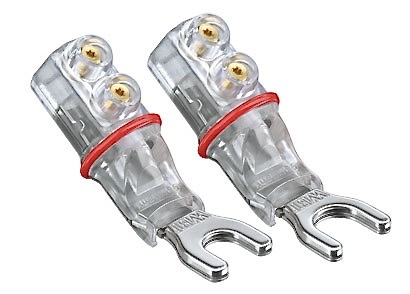
WBT-0681 Ag Spades
The spade connectors are the latest nextgen™ Sandwich Spade WBT-0681 Ag with a special PlasmaProtect gold coating, which WBT only makes for Crystal Cable. WBT's PlasmaProtect coating is a very special process on its own, used on their copper connectors. At Crystal Cable's request they perform the treatment on their silver connectors too, leading to even higher quality connection than with the regular WBT-0681 Ag. These are beautifully designed (and expensive!). If you look closely, the spade is a sandwich of oxygen-free copper that is gold-plated to protect against oxidation and the body of the plug is a see-through composite material. The banana connectors are nextgen™ WBT-0610 Ag with PlasmaProtect coating.
Short Tech Description Provided by Crystal Cable
Infinite Crystal Silver has revolutionized our approach to the construction and termination of both loudspeaker cables and power cords. The creation of long, single crystal conductors has lowered micro-distortion and resistance—both critical factors in meeting the demands of large current signals with rapid rise times. But what is even more critical is lowering transmission impedance.
By manufacturing each conductor's co-axial shield from the same Infinite Crystal Silver, it allows us to create a cross-balanced topology that cancels induced distortion without introducing time and phase errors. It makes possible to produce cables with remarkable geometrical and electrical consistency. The resulting fully shielded speaker cables are our fastest, quietest, and most dynamically responsive designs to date.
Set-up and Burn-in
Each of my CH Precision M1.1 monoblocks have two sets of binding posts. To take advantage of their full output power I run two sets of speaker wire to my YG Anat Signature speakers. Each set received three or four days on the Cable Cooker (Crystal advises a minimum of 100 hours burn-in), at which point they presented a clean, pretty, resonant sound with an upward-tilted tonal balance, sounding much like good quality silver speaker wires. With another day and half playing music some bass showed up, but it was still tonally cool. Given one more day, there was no more silver sound. The Van Gogh stabilized to reveal a transparent view with little coloration, neither cool or warm tonal temperature—kind of neutral.
Wood blocks for cable support
The speaker cables are fully shielded. However, I found them sensitive to RFI/EMI contamination and made every attempt to route the wires in a way that reduced cable interactions, especially with power cords. They are also particular about cable supports. Among my inventory, they preferred wood ones, either walnut or maple.
Conclusion
I posed two questions earlier: How does Crystal Cable's new Infinite Crystal Silver (iCS) conductor material perform in a speaker cable? What is the impact of doubling up the number of conductor runs? I now have preliminary answers.
As implemented in the Van Gogh Speaker Cable, don't expect a seismic quake that realigns the sonic firmament. You'll find the lay of the land largely intact from where you started out (provided you began from a fairly neutral base). The differences show up on a finer scale, including: an expansion of dynamic range at both extremes, from the near silences to the ability to reach f and keep going to fff with conviction; the excavation of fine details that smooth and refine musical flow; and an increase in instrumental body.
But what really sold me was how the Van Gogh closely mimicked the way instruments speak and move on the stage, how they change shape and reform harmonics as they move around the scale. All of this excitingly nudges the home experience closer to what I hear in the concert hall. While I've heard other wires do this on rare occasion, it's only attained from premium-priced cables and it was never to this degree. The Van Gogh is one of the select few that signify the end of the quest, one that I'd be happy to take to the desert island.
On an aesthetic level, these new Art Series wires belong in a gallery. The Van Gogh's minimalist design, attention to detail, and fine workmanship inspire many to consider them audio objets d'art—as well they should, at $29,200 USD for a 2m run.
Van Gogh Speaker Cable
Retail: $29,200/2m
Crystal Cable








